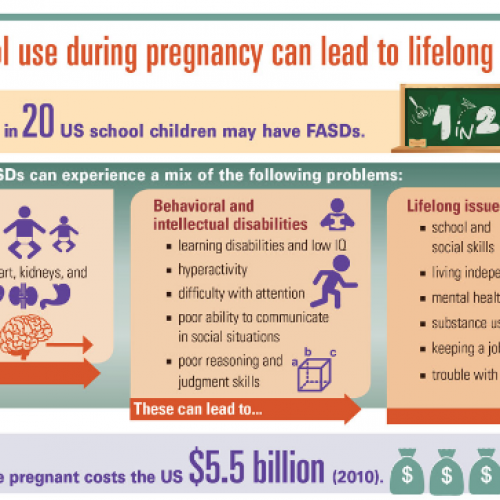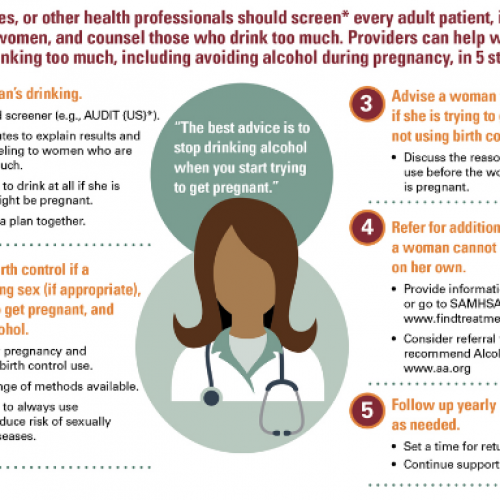Fetal Alcohol Spectrum Disorders

Definition
Fetal alcohol spectrum disorders (FASDs) are a group of conditions that can occur in a person whose mother drank alcohol during pregnancy. These effects can include physical problems and problems with behavior and learning. Often, a person with an FASD has a mix of these problems
Peer Reviewed Journal Articles
Prevalence of Fetal Alcohol Spectrum Disorders in 4 US Communities
May, P.A., et al. Prevalence of Fetal Alcohol Spectrum Disorders in 4 US Communities. JAMA. Online February 6, 2018
Importance: Fetal alcohol spectrum disorders are costly, life-long disabilities. Older data suggested the prevalence of the disorder in the United States was 10 per 1000 children; however, there are few current estimates based on larger, diverse US population samples.
Objective: To estimate the prevalence of fetal alcohol spectrum disorders, including fetal alcohol syndrome, partial fetal alcohol syndrome, and alcohol-related neurodevelopmental disorder, in 4 regions of the United States.
Women’s Knowledge, Views and Experiences Regarding Alcohol Use and Pregnancy: Opportunities to Improve Health Messages
Elvira Elek, Shelly L. Harris, Claudia M. Squire, Marjorie Margolis, Mary Kate Weber, Elizabeth Parra Dang & Betsy Mitchell (2013)Women’s Knowledge, Views, and Experiences Regarding Alcohol Use and Pregnancy: Opportunities to Improve Health Messages, American Journal of Health Education, 44:4, 177-190, DOI: 10.1080/19325037.2013.768906
This focus group research study examined women’s knowledge and beliefs about alcohol consumption and its risks during pregnancy along with related perceptions of social influences and information sources in order to inform future messaging.
Prevalence and characteristics of women at risk for an alcohol-exposed pregnancy (AEP) in the United States: estimates from the National Survey of Family Growth.
Tan CH, Hungerford DW, Denny CH, McKnight-Eily LR. American Journal of Preventive Medicine 2017; DOI: 10.1016/j.amepre.2017.11.008. Epub December 11, 2017
Non-pregnant women can avoid alcohol-exposed pregnancies (AEPs) by modifying drinking and/or contraceptive practices. The purpose of this study was to estimate the number and characteristics of women in the United States who are at risk of AEPs.
Books
Understanding Fetal Alcohol Spectrum Disorder: A Guide to FASD for Parents, Carers and Professionals
Understanding Fetal Alcohol Spectrum Disorder (FASD) is a useful introduction to the most common non-genetic learning disability, which is caused by alcohol consumption during pregnancy. Accessible and informative, this is the essential guide to FASD for social workers, family placement teams, child protection workers, foster carers, adoptive parents, midwives and teachers
Catterick, M., & Curran, L. (2014). Understanding fetal alcohol spectrum disorder: A guide to FASD for parents, carers and professionals. London: Jessica Kingsley.
Fetal Alcohol Spectrum Disorders in Adults: Ethical and Legal Perspectives: An overview on FASD for professionals
Fetal Alcohol Spectrum Disorders in Adults: Ethical and Legal Perspectives: An overview on FASD for professionals
This book discusses and provides insight on the legal and ethical dilemmas of managing those with Fetal Alcohol Spectrum Disorder (FASD). This book provides a clear perspective for those clinicians and legal professionals who are working with those with this disorder, and correspondingly increases their understanding when arranging effective supports for this population. Historically, the primary focus on FASD has been on children. However, this is a lifelong disorder and the implications of this disorder become even more prominent and complex in adulthood.
Nelson, M. (2016). Fetal alcohol spectrum disorders in adults: Ethical and legal perspectives; an overview on FASD for professionals. Cham: Springer.
Fetal Alcohol Syndrome: A Guide for Families and Communities
Fetal Alcohol Syndrome: A Guide for Families and Communities
Readable and easy to understand, this book conveys urgent information about medical and social issues surrounding fetal alcohol syndrome (FAS).
Streissguth, A. P. (2012). Fetal alcohol syndrome: A guide for families and communities. Baltimore: Paul H. Brookes Publishing.

Current Top Websites
NOFAS educates the public, practitioners, and policymakers about the risk of prenatal exposure to alcohol, drugs, and other substances known to harm fetal development including tobacco, marijuana, heroin and other opioids, cocaine, and methamphetamine, recognizing that these substances are often used simultaneously. NOFAS supports individuals and families living with FASDs through referrals, advocacy, training for professionals, information dissemination, and a wide range of diverse initiatives and resources.
An important new online resource is now available to help people recognize and find high quality treatment for alcohol use disorder (AUD), which affects more than 15 million adults in the United States. The NIAAA Alcohol Treatment Navigator helps individuals and their loved ones negotiate the often-complicated process of choosing treatment for alcohol misuse by telling them what they need to know, and what they need to do, to recognize and choose quality care
The overall goal of the Mountain Plains Fetal Alcohol Spectrum Disorders Practice and Implementation Center (Mountain Plains FASD PIC) is to introduce, improve, and sustain the knowledge and practice behaviors of medical assistants (MAs), particularly MAs certified by the American Association of Medical Assistants, in preventing and intervening with risky and hazardous alcohol use which are supported by the adoption of evidence-based interventions in clinical practices. Specifically, this project is focused on reducing and ultimately preventing alcohol-exposed pregnancies by way of utilizing medical and allied health professionals working on interprofessional health care teams who have access to patients who are pregnant or are of reproductive age.

Webinars and Online Trainings
Diagnostic Overview of FASDs: Recognition and Referral
This online training course provides information on screening and assessing individuals for fetal alcohol spectrum disorders (FASDs). This course provides continuing education credits, and allows learners to save their progress—thus offering the flexibility to take the training as schedules permit.
FASD Primer for Healthcare Professionals
This online training course provides the learner with a broad foundation of knowledge about fetal alcohol spectrum disorders (FASDs). Topics include prevention, identification, referral and treatment of FASDs. This course provides continuing education credits, and allows learners to save their progress—thus offering the flexibility to take the training as schedules permit.
Preventing Alcohol-Exposed Pregnancies (AEPs)
This online training course discusses the importance of preventing AEPs and provides two evidence-based approaches that healthcare professionals can use to help prevent AEPs. This course provides continuing education credits, and allows learners to save their progress—thus offering the flexibility to take the training as schedules permit.
Infographics
Latest Tools
The Fetal Alcohol Spectrum Disorders (FASD) Toolkit was developed to raise awareness, promote surveillance and screening, and ensure that all affected children receive appropriate and timely interventions.
TIP 58: Addressing Fetal Alcohol Spectrum Disorders (FASD). This guide reviews screening tools for alcohol use and interventions for pregnant women and women of childbearing age to prevent fetal alcohol spectrum disorders
The FASD Competency-Based Curriculum Development Guide for Medical and Allied Health Education and Practice is designed to improve prevention, identification, and management of FASDs and can be used to develop educational programs and materials in a range of formats based on the needs of learners.


